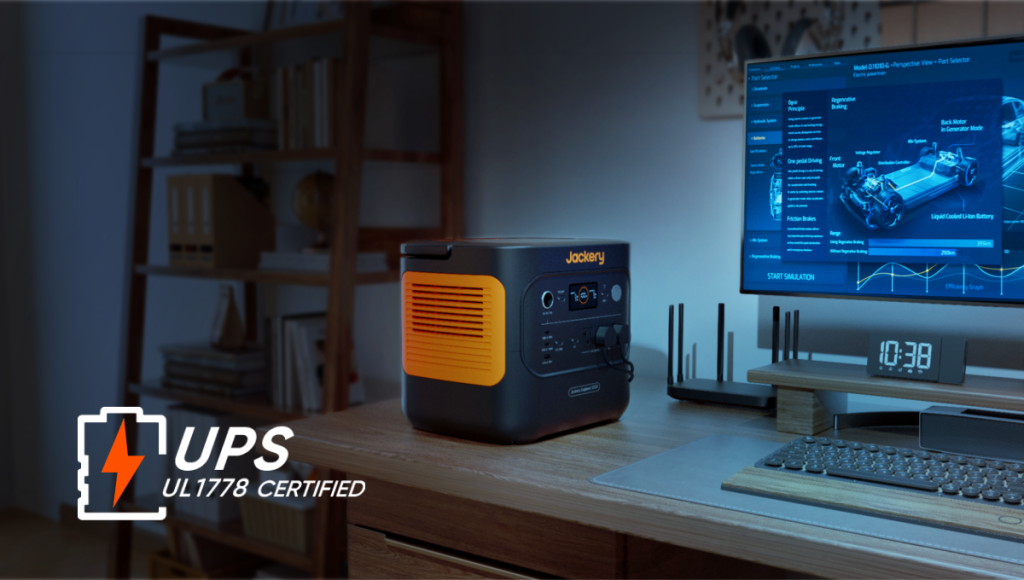Canada is widely recognized for its sweeping forests, dramatic coastlines, and long, snowy winters. Given the country’s unique terrain, many people wonder if Canada is also prone to earthquakes and whether they should be considered a serious concern or an occasional event. This article provides a clear and fact-based overview of Canada’s earthquake activity. It examines where seismic events occur most frequently, their typical strength, and which regions are most at risk. It will also guide you in choosing the right essentials while preparing for an earthquake emergency. Similarly, the article also explains how a reliable backup solar panel generator, such as the Jackery Solar Generator 2000 v2, can help you stay safe and connected during unexpected disruptions.
So, what causes earthquakes in Canada, and how can you prepare for them? Let’s see:
The Earthquake Activity in Canada: The Overview
Canada’s geological position explains much of its earthquake activity. The country is present on the northern portion of the North American Plate, interacting with the Pacific Plate, the Juan de Fuca Plate, and several smaller tectonic structures. These boundaries generate stress in the Earth’s crust, and when that stress is released, earthquakes happen.
Although Canada is not among the most earthquake-prone nations, it still experiences regular seismic events. Thousands of quakes are recorded each year, with some of them resulting in the noticeable disruption of life while others pass unnoticed. Western Canada sees the highest earthquake activity, but minor events can occur across a much wider area, including central and eastern provinces.
Most earthquakes in Canada fall into the low magnitude category, often below level 4 on the Richter scale, and rarely cause noticeable damage. Moderate quakes occur less frequently, and strong ones are rare, but history shows that they can still happen and bring life to a standstill. Seismologists study both the smallest and largest events to understand how stress is distributed in the Earth’s crust and how the tectonic plates are changing their positions over time. Tracking these patterns helps them improve hazard maps and provide accurate assessments of which areas are most prone to risk and which areas are relatively safer.
Understand the Regions in Canada Most Affected by Earthquakes
Now let’s have a look at how earthquakes can affect different regions of Canada:
West Coast (British Columbia)
British Columbia has the highest seismic risk in Canada. The province lies along the Pacific “Ring of Fire,” where the Juan de Fuca Plate slowly moves beneath the North American Plate at the Cascadia Subduction Zone. This tectonic boundary is capable of producing extremely powerful earthquakes, with some of them reaching a magnitude of 9 in the past. In addition to that, the Queen Charlotte Fault, off Haida Gwaii, is another active source of large quakes. Thousands of smaller tremors occur in this region each year. While this is true that most of them are too weak, they still show the presence of seismic activity in the region. Researchers continue to closely monitor these zones to refine early warning systems and inform preparedness efforts.
Quebec and Ottawa Valley
Eastern Canada is far from the major plate boundaries, yet some areas remain seismically active. The Western Quebec Seismic Zone and the Charlevoix region, located along the St. Lawrence River, are known for producing moderate earthquakes. Historic events such as the 1935 Timiskaming quake and the 1988 Saguenay quake caused extensive damage and were felt across wide areas. Hundreds of smaller tremors occur in this region every year, though only a few are strong enough to disrupt the cycle of life. Ancient faults buried in the bedrock are thought to drive this activity, showing that even areas far from active plate boundaries can experience earthquakes.
Geologists pay close attention to these regions because the high population density increases the possibility of disruption in the case of any incident. Even a moderate event here could have significant social and economic effects. The detection of tremors in areas far from the coast prompts scientists to examine deeper structural features that may be more prone to shifts in the future.
Northern Canada
The northern territories experience fewer quakes than British Columbia or Quebec, but seismic activity is still present. Fault systems such as the Tintina Fault in the Yukon and crustal movements in the Northwest Territories have generated earthquakes in the past. The Arctic has also recorded significant offshore events, such as the 1933 Baffin Bay earthquake, one of the largest ever documented in the region. Because many of these areas are sparsely populated, the impact on people is limited, but geologists keep a close watch since the underlying structures are capable of producing sizable tremors.
Remote monitoring stations play a key role in detecting activity in this region. Data collected helps researchers understand how seismic energy travels through Canada’s northern geology. The ongoing research into these regions could reveal how such activity may increase in the future due to changing geological conditions and climate impacts.
Preparedness and Monitoring of Earthquakes in Canada
Canada has a well-established system of hierarchy for monitoring earthquakes and helping people prepare for potential seismic activity. Here is how the country monitors and prepares for these incidents:
Role of Natural Resources Canada (NRCan)
Earthquake monitoring in Canada is led by Natural Resources Canada (NRCan). The agency operates a nationwide network of seismic stations that record thousands of tremors annually. These records are analyzed to determine where earthquakes occur, their intensity, and the associated risk. NRCan also issues real-time earthquake updates through its public database, giving communities and officials access to reliable information for planning and response.
Building Codes and Infrastructure Standards in High-Risk Areas
Canadian construction standards include detailed seismic requirements to reduce earthquake damage. The National Building Code establishes a framework, while more vulnerable provinces adopt additional measures in accordance with the levels of risk. Engineers design modern buildings with the structural requirements in mind, ensuring that the safety of occupants is not compromised.
Public Awareness and Emergency Preparedness Campaigns
Raising awareness and preparing communities for potential dangers are crucial components of Canada’s strategy to mitigate earthquakes. National and regional programs encourage people to learn what to do before, during, and after an earthquake. Schools teach safety drills, while local governments and community groups organize workshops and distribute guides to help residents understand potential risks. Broadcasts, mobile apps, and community events make sure information reaches as many people as possible, including those in remote or multilingual areas.
Social media and digital platforms have increasingly become tools for spreading preparedness information. Campaigns now reach more people through these channels, offering an accessible way for Canadians to stay informed and ready.
Here is a complete checklist of essential items to keep on hand when preparing for an earthquake:
- First-aid kit: A well-stocked first aid kit is vital when access to professional medical care may be delayed after an earthquake. It should include bandages, antiseptic wipes, adhesive tape, pain relievers, and any prescription medications for treating cuts, bruises, or sprains quickly.
- Drinking water and non-perishable food for at least 3 days: Keep sealed bottles of water, canned goods, energy bars, and baby formula if needed. A manual can opener and disposable utensils are also useful, allowing you to prepare meals without power or access to running water.
- Flashlights with spare batteries: Reliable lighting is important in dark or damaged areas where broken glass or debris may be present. Keep several flashlights, ideally LED models, and extra batteries in a dry container.
- Portable radio for updates: A battery-powered or hand-crank radio allows you to receive emergency announcements when mobile networks are unstable. Local stations often share evacuation routes, shelter information, and rescue updates during a crisis. Make sure the radio is easy to operate and check it periodically to confirm that batteries are charged or that the crank works smoothly.
- Fire extinguisher: Fires caused by damaged wiring, leaking gas, or overturned stoves can spread quickly after an earthquake. Keep a multipurpose fire extinguisher in an accessible location and learn how to use it safely.
- Whistle for signalling in case of entrapment: A sturdy whistle can save lives if you become trapped under debris. Attach it to a keychain or emergency bag so it is always within reach.
- Warm clothing, blankets, and sturdy footwear: After an earthquake, you may need to wait outside or walk across uneven ground. Pack extra layers, thick blankets, and durable shoes to protect against cold weather, sharp rubble, or spilled liquids.
- Waterproof folder with key documents: Keep identification, insurance policies, medical records, and other important papers in a waterproof folder or resealable bag so that they are not damaged.

- Solar generator for powering everything: A solar generator is an essential part of an earthquake preparedness plan because it keeps vital equipment running when power lines fail. After a significant quake, electricity can remain out for hours or even days, leaving families without light, communication tools, or the ability to charge phones and radios. A reliable solar generator, such as those manufactured by Jackery, provides clean energy without relying on fuel supplies that can get disrupted during earthquakes. A reliable emergency power supply can also power flashlights, emergency radios, medical devices, or small kitchen appliances, helping households stay safe and informed while waiting for services to be restored. Using a solar-powered option also avoids the hazards of fumes or noise from traditional gas generators, making it safer for indoor or confined use.
Introduce Jackery Solar Generator 2000 v2 for Home Backup
The Jackery Solar Generator 2000 v2 provides a reliable way to power your electronic appliances during power outages and emergency situations. It is designed as a compact yet capable energy backup that can store 2042 watt-hours of energy and delivers 2200 watts of continuous power, which is enough to operate almost every appliance you would need during emergencies.
Due to the availability of three AC sockets, USB-C and USB-A ports, you can plug-in numerous appliances at once and get the most out of the available battery.
Since this portable power station with a complete set of solar panels provides fast recharging opportunities, you can quickly top up the battery during emergencies. It comes with an emergency supercharge option, which lets you restore the battery pack in as little as 1.7 hours. A standard wall outlet will let you recharge the battery in just 1.75 hours, while pairing the unit with 4 Jackery SolarSaga 100 W Solar Panels completes charging in roughly 7.5 hours.
And, when the grid goes down, this power generator will automatically switch over to backup power in less than 20ms, which means that you can continue using all the devices without any downtime.
For Canadians preparing for earthquakes and other emergencies, this solar panel generator strikes a balance between fast charging, strong output, and a safe design. Keeping this generator on hand means families can maintain lighting, refrigeration, internet access, and other essentials, even when an earthquake interrupts the main supply.

Conclusion
Earthquakes in Canada are less frequent than in many parts of the world, yet they remain a real risk, especially along the British Columbia coast and in parts of Quebec, the Ottawa Valley, and the North. Most tremors are small, but history shows that larger events can occur, making preparation essential. National monitoring systems, strong building standards, and clear public guidance help communities stay informed and safe. A practical emergency kit, supported by dependable backup power such as the Jackery Solar Generator 2000 v2, provides families with the tools to manage outages and protect essential needs until essential services are restored.

